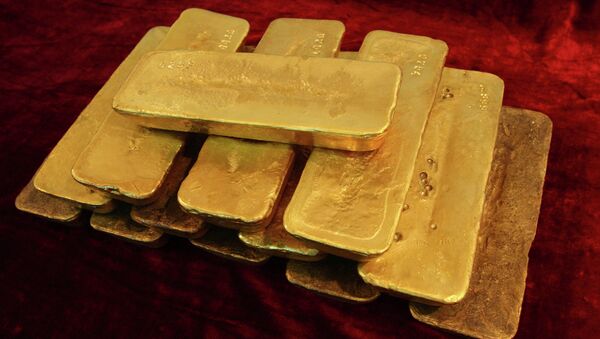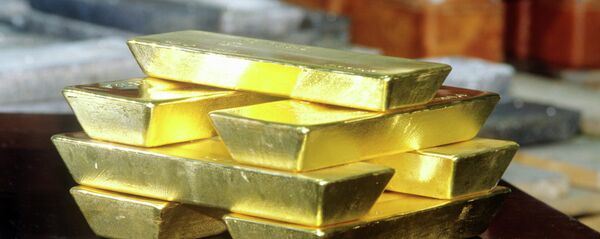Kristian Rouz — Safe-haven assets retreat as the global rally in equity and debt markets broadens with the recent risks stirred by Greece and mainland China having eased somewhat. Against this background, precious metals are among those assets most affected by the market dynamics, not least due to a rally in the US dollar. Consequently, investors hurry to get rid of gold, buying into more liquid and profitable assets like equities of hard currencies.
The global metals markets were hit by a broad sell-off on Monday, with gold prices having tumbled to as low as $1,088/oz (-4%) during the trading sessions, settling at their 5-year lowest of 1,110/oz (-1.93%). The multi-decade lowest in gold prices is $1.080/oz. The ongoing rise of the US dollar, having hit its 3-month highest on Monday, the global relief rally in equities and the rise of investment appeal of the European debt markets have all been factors of the decline in gold valuation.
The slump in gold is likely to deepen, as the US Fed edging closer to a rate hike, causing a rising demand for the US currency. Meanwhile, inflation in most developed nations is below acceptable, flat or even negative, rendering buying into gold a losing strategy. While the higher-yielding markets are doing relatively well, investment capital is fleeing metals markets, and the sell-off is frantic.
There is a significant bear momentum in the precious metals markets. The currently negative trend in the gold market might reverse only in case of an exacerbated global financial turmoil. However, the current supply of gold is relatively high, meaning even at a higher demand the yellow metal is unlikely to rise above its last year's average price of $1,130-1,146/oz.
Gold is more likely to break its multi-decade low of $1,080/oz, which would be a serious psychological blow to the market, which will only depress the price further.
Platinum dropped 5% on Monday, to its 6-year low, at $987.40/oz. It was previously projected to fluctuate between $1,070-$1,089/oz, however, the downward trend is gaining momentum. Platinum is now nearing its 2004 levels of $950-955/oz., and in case of metal markets recovery, it will hardly rise above $1,010-1,015.oz, given the current dynamics in supply-demand correlation.
Recently, the Fed chair Janet Yellen said the regulator will move the base interest rate up if the economy expands further. As a recession is very unlikely in the US, there is little doubt of the US borrowing costs, spurring a greater last-moment demand for the monetary liquidity. Also, the St. Louis, MO, Fed chief James Bullard said on Monday there is a higher than 50% chance of a September hike.
The dollar rose 0.14% against the yen to 124.26, triggering a massive equity rally in Japan, as the nation's exporters are nearly ecstatic in the dearer greenback environment. The British sterling fell 0.08% against the dollar to $1.5587 as the Bank of England postponed its plans to raise base interest rates until early next year. The US dollar also gained against its Aussie and Loonie counterparts.
The dollar index is now at 97.858 after hitting its highest level since April level at 98.088 earlier on Monday.





